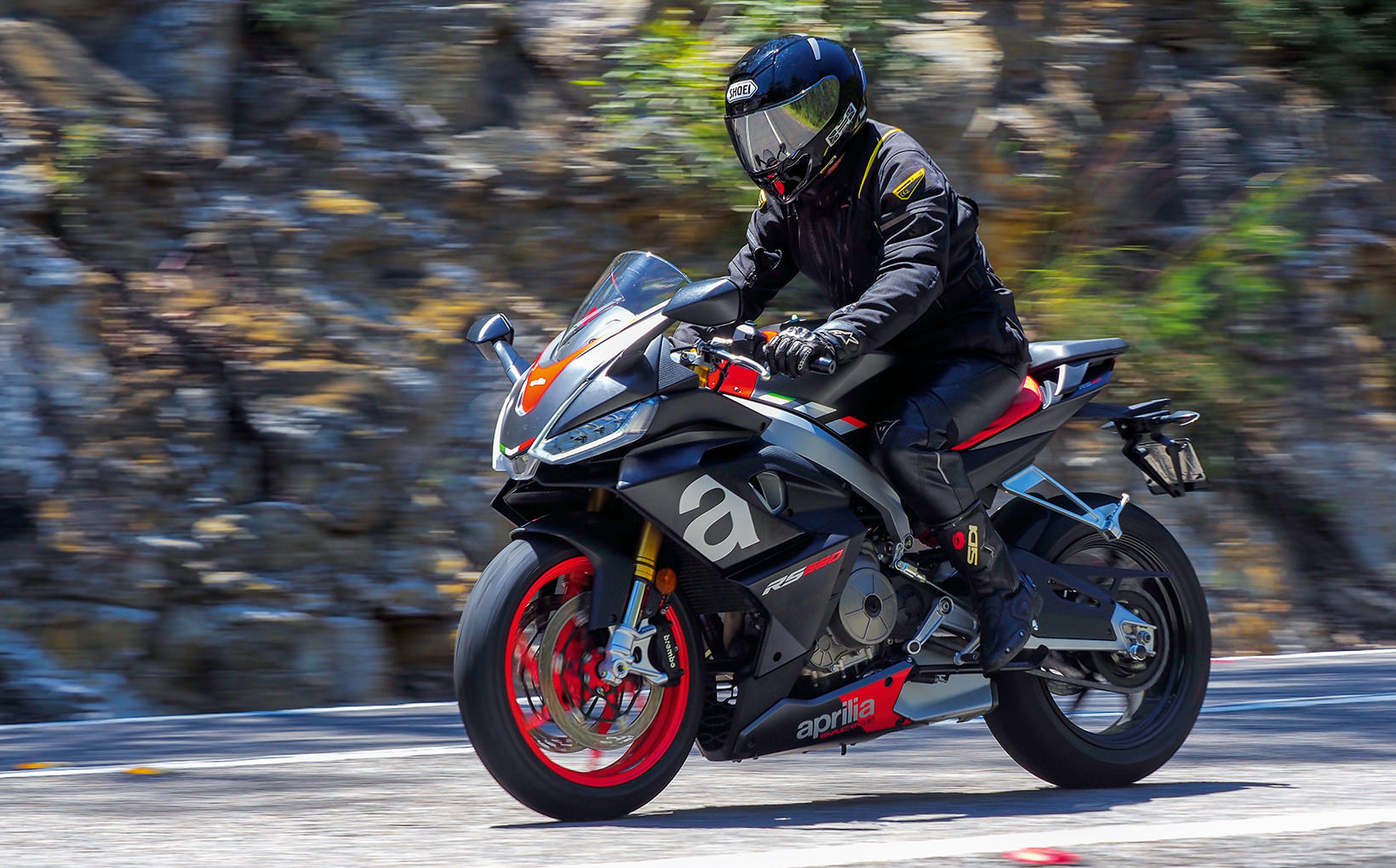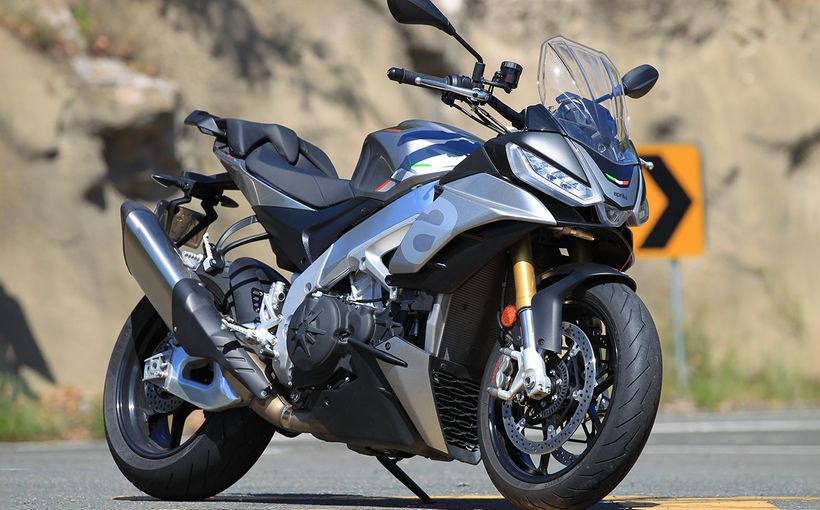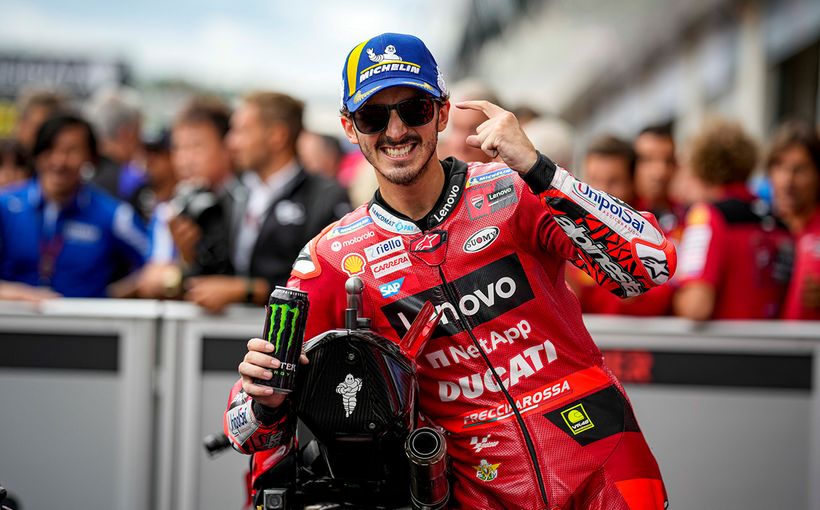Aprilia RS 660: A New Italian Twin

BY: PHIL JAMES | PHOTOS: NIGEL PATERSON/SUPPLIED
With incredible punch to launch you out of corners, an SWC-derived chassis built for stiffness and a compact nature which makes it one of the smallest in its class, the Aprilia RSV4 is an amazing machine — but it’s also too powerful, too expensive, too cramped and too much for most people.
So maybe cut out a couple of cylinders, adapt the design to suit a wider range of riders and build it at a reasonable price to increase sales? Enter the RS 660.
It’s Aprilia’s re-imagining of what a middleweight sports bike can be, but it’s interesting Yamaha had a similar idea with the R7 (the two bikes were announced so close together it’s unlikely one is a response to the other).
Not only that, we’re getting two versions — the full power RS 660 and a LAMs approved model. Pricing varies a little depending on where you live, but a little under $21,000 ride away for the full power or $500 less for the LAMS version puts the new machine in the premium mid-range pricing area but nowhere near open class sportsbikes.
The design philosophy attempts to wrap serious performance in a practical and beautiful package. We’ve seen it before in Supersport 600s, which were sporty and yet somewhat practical in the 1990s before turning into racing specials … then losing relevance as open-class sportsbikes became easier to ride with good traction control and engine maps, taking away the advantage of the smaller engine. The 600s are extremophiles — everything exciting happens above 11,000rpm. Sadly, it’s an unavoidable consequence of their laser design focus on lap times. That blistering track performance isn’t easy to access either; considerable skill is required to keep the crank spinning in the performance zone for any length of time.
With the RS 660, Aprilia is attempting to capitalise on this Supersport “practicality deficit”, moving the dial back towards real world performance and fun; but how much performance does it give up? Not that much as it turns out, and in many ways, it offers a better experience than a 600 four.

WHAT’S ON OFFER?
Aprilia must face a tricky PR issue with the RS 660. That being for most sport punters, a 660cc twin won’t set the blood racing. Fortunately for Aprilia, if they can be persuaded to look closer at the specs, that may change. Here’s an overview to drive home the point.
The 183kg kerb weight (169kg dry) hasn’t been seen in a serious middleweight since Euro emission compliance started porking bikes up 15 years ago. It’s roughly 10kg lighter than the Euro 5 Supersport 600s.
The parallel-twin engine is extremely compact, delivers 100hp (10,700rpm) with 80 per cent of its torque on offer from 4000rpm. This is exceptional for a middleweight twin. Another twin advantage (compared to a four) is the reduction in rotating mass and its distance from the engine’s centre of mass. This reduces gyroscopic effect, making the bike more responsive to rider input.
It has the feel of a V-twin, thanks to the offset firing order (270-degree crankshaft) which has become the norm in recent years for newly designed parallel two-pot motors.
The compact engine also allows a short wheelbase (for quick turn capability). The aluminium beam frame features typical sports geometry providing a good blend of agility and stability. Stability is further assisted by its 104.6mm trail figure (giving weight to the steering input effort) and the sophisticated fairing aerodynamics.
Suspension is good quality, but mid spec. Both ends have preload and rebound adjustment only. Shock rebound adjustment requires removal of a body side panel — not ideal. The “could be better” suspension spec suggests there may be a factory variant with premium components in the future.
The braking package doesn’t take any short cuts though, with Brembo radial four-piston calipers, radial master cylinder and braided lines. The rear features a Brembo twin-piston caliper and braided lines. This isn’t that far from what’s offered on the RSV4 superbike.
The electronic package is arguably the best on offer in the middleweight segment utilising Aprilia’s acclaimed APRC software. It’s fully featured, with good rider customisation offered.
It’s possible to dull the bike down, or sharpen it up via either three pre-set or two customisable modes. Various amounts of throttle sharpness, engine braking, traction control and ABS intervention are modulated to suit the mode’s intended use. Interestingly, one mode is called “Commute” and that gives an important clue to the bike’s character.
Flipping between the modes is easy via a dedicated button on the right switch block. Wheelie control can be turned off for those special moments.
As far as sports bikes go, rider comfort is a highlight of the RS 660. There’s cruise control, clip-ons sitting above the triple clamps and a shortish “reach to bar” dimension.
The seat foam nails the “tyre feel vs comfort” trade off and the controls (except for the cable clutch) are all adjustable.

THE RIDE
I’ve previously owned a Japanese 600 with an ABM high bar conversion — it was an absolute cracker street bike. So much so, I had it for the best part of 10 years. Interestingly, benchmarking the RS against that bike threw up a few surprises I’ll detail in a moment, but first the bread and butter stuff.
The RS isn’t large, but it’s not tiny either, so riders of all sizes are accommodated. The seat is highish, making it easier to shift one’s weight in “attack” mode, and the bike’s overall lightness and thinness means the short legged won’t find slow-speed manoeuvres intimidating.
The riding position is certainly “sporting” but, impressively, I could manage a few hours on it before significant shoulder discomfort — something I’ve not been able to say about a clip-on bike for a long time (if ever).
The RS is well behaved in urban traffic with good fuelling, excellent manoeuvrability, mirrors that kinda work (it’s Italian — functional sports bike mirrors aren’t part of the national character) and progressive, strong brakes.
The powerful Euro 5 engine is an impressive example of combustion efficiency, and this translates into very good fuel economy. Typically, less than 4 litres/100km for the test period so the 15-litre tank isn’t a drawback. My maxi scooter can’t match that.
All this relative comfort, plus practicality, engine user friendliness, good fuel economy, good tyre wear; and (in NSW at least), cheap rego, allows the RS to pull off a trick virtually no other supersport can manage. It’s a cost-effective commuter! That’s surprise number one.
There are obviously better choices for commuting (with reduced depreciation cost and better luggage options), but if a potential buyer must have cheap weekly running costs, the RS 660 delivers them.
Once the commuting is done and the weekend arrives, the sport part of the bike’s character reveals itself; and it reveals itself as … a very quick motorcycle! As with its low-speed ability, when it gets serious, the RS 660 remains a practical piece of kit.
Time to put on sport bike testing helmet and drill into this…
The RS660’s suspension allows the bike’s springing to be balanced for load — that’s it. Fortunately, Aprilia have got the base compression settings spot on. When the springing is softened (for road mode) wheel control is still maintained and comfort at speed on bumpy roads is quite acceptable.
Tightening everything up should allow track acceleration and braking loads to be resisted. We didn’t ride the RS on a track, but my feeling is it’s up for it, and would be a lot of fun (although using the swing arm as foot peg heel plates is odd).
The engine can best be described as functional at low rpm, forceful in the midrange and furious in the top end. Aprilia talk this engine up and they’re not exaggerating, it sets a new benchmark for mid-capacity twins. If matched against a one-litre bike, the big bore isn’t going to instantly disappear into the distance.
It has it over most 600 fours when “sport biking”, as its midrange punch is sufficient to avoid stratospheric revs all the time and has gone straight to the top of the class when comparing it to any midrange twin. Although, it needs more revs than an open class bike to really mumbo.
When the throttle is pinned, it becomes clear to a bystander this is no asthmatic twin either; rather, the bark suggests a machine not to be messed with. Another selling point for the shallow amongst us…
One thing many riders may notice is a band of increased handlebar vibration between 100 and 110km/h. As readers will be aware, in Australia that’s an unfortunate speed range.
It’s likely to be partially due the sky-high 13.5:1 compression ratio required for the engine’s stellar performance and fuel economy. The rigidly mounted clip-on ’bars probably magnify it, and it would be interesting to ride the Tuono variant (with conventional bars and rubber peg inserts) to see if it’s smoother. Using smooth, slow burning 98 octane fuel may help as well.
This is not a fatal flaw, it’s more a case of it attracting reviewer attention because it’s the only engine behaviour that isn’t top class — but it’s still mid class.
Braking stability is pure premium and steering is precise. Once a rider acclimatises to the steering, it’s very easy to place the bike exactly where it needs to be, and very easy to flick it in another direction as required. This is the bike’s big party trick and why it’s so, so quick through a series of corners.
The unique package of engine, frame, suspension and weight distribution results in a bike that’s un-intimidating and comfortable; yet gives up very little to the big boys. Extracting its best is also a realistic possibility; and trying to do so is both challenging and fun. So much so, 90 per cent of riders will be faster on the RS than the super potent 1100cc RSV4. It’s that good — and that’s surprise number two, and it’s a big one!

THINGS WE NOTICED
The quick shifter is pretty good and when it’s happy, it will rip through the gears. Sometimes it’s not happy, and it can be a reluctant down-changer or a clunky up-changer.
The key to keeping it happy on down shifts seems to be ensuring there’s zero throttle (not even one per cent) and waiting till the gear lever returns to rest position before re-engaging the throttle. This is good riding technique anyway, but if rider concentration is lacking, the quick shift will punch back.
Up-shifts require moderate throttle and rpm for smooth shifts. Taking the time to adjust the lever to the rider’s foot helps as well.
We did notice the gear shift mechanism is a bit stiff, indicating a strong detent spring. This provides a positive gear change, although it can be tiring when continually shifting for more than a few minutes (at one point I thought my big toe might blister).
The fairing isn’t just a piece of stylish Italian design. It works well, protecting the rider better than its compact dimensions suggests. It also contributes to the bike’s extremely good straight-line stability. Even at motorway speeds the RS is strikingly stable and planted. At “closed course” speed, it’s probably up there with the best winged offerings.
Those with smaller hands (like myself) may need to consider the accessory span-adjustable levers. As they come, they’re a bit far away from the bars. I adjusted the Brembo master cylinder to its minimum position and it was just OK.
The throttle spring is firm and may induce wrist/finger fatigue on a longer ride. Whilst a stronger spring makes for easier throttle position feel on a racetrack, in a street situation it’s a drawback. Using the cruise control wherever possible helps manage it when fatigue sets in.
The RS 660’s striking style gives it impressive road presence, and this is kicked up another notch with the Daytime Running Lights. They have two intensities: bright and super bright. Any tin top claiming not to see them will just be admitting they were looking at their phone.
Other features of the lighting package include blinker function built into the DRLs and a twilight sensor to automatically switch on the low beam. There’s a corner light function to illuminate the inside of the turn, and as with most of these systems, it works, but not as well as you’d like. One thing that is an excellent inclusion is self-cancelling blinkers that flash in an emergency braking manoeuvre.
The cruise control has a set point read out in the dash. To vary the desired speed, it’s a matter of changing the set point, rather than just pushing the faster/slower buttons hoping to eventually land on the desired speed.
The RS 660 also follows the trend towards toolkit elimination. There’s an Allen key (fitting fairing bolts) attached to the bottom of the seat. As far as we know, that’s it. Supplementing it with additional tools would be difficult as there is little space under the seat, and what space there is, is too short for most tools.

WHAT WE’D DO IF WE OWNED IT
The RS is a complete package as it comes. As with all bikes, radiator and fall-over protection never goes astray and adding bling is always fun. It would be better with a lighter, flashier exhaust and premium shock, but it’s not crying out for these things. Consequently, Aprilia deserves a bouquet for the OEM stuff.
CONCLUSIONS
I wasn’t expecting the RS to match my old, high bar converted 120hp/170kg 600, but it does. The 600 would beat it in a drag race and possibly around a racetrack, but there are significant trade-offs to get that seldom used advantage. However, through a set of public road corners, I’d back the RS as the better machine. Our feeling is it would be a heap of fun and acquit itself well at a track day too.
Importantly, the RS rider largely avoids the soul crushing, slow speed fatigue all the 600s exhibit on public roads.
This is a sport bike that’s very well rounded, and for riders not obsessed with a lap time, it makes more sense than a 600 Supersport, or an open class Superbike. It’s as fast on the road, more fun, more comfortable, more commutable — and a whole lot cheaper.

SPECIFICATIONS APRILIA RS 660
ENGINE
Type: Liquid-cooled, 4-stroke, DOHC, 4-valve, parallel 2-cylinder, balance shaft fitted
Maximum power: 100hp at 10,700rpm
Maximum torque: 67Nm at 8500rpm
Capacity: 659cc
Bore x stroke: 81 x 63.93mm
Compression ratio: 13.5:1
Fuel system: Fuel Injection twin 48mm throttle bodies
Ignition: Electronic
Transmission
Type: 6-Speed
Final drive: Chain
Clutch: Wet multiplate with anti-hopping mechanism
Homologation: Euro 5
Chassis and Running Gear
Chassis: Double beam aluminium
Swingarm: Aluminium
Front suspension: KYB telescopic upside-down 41mm fork, rebound, spring preload adjustment, 120mm travel
Rear suspension: KYB shock with rebound and ring style preload adjustment, 130mm travel
Front brakes: Brembo radial-mount 4 piston calipers, semi-floating dual discs, 320mm, radial master cylinder, braided metal lines, ABS
Rear brake: Brembo twin-piston caliper, 220mm disc, braided metal lines ABS
Tyres: Front: 120/70ZR17 Rear: 180/55ZR17M/C
ELECTRONIC RIDER AIDS
Aprilia Performance Ride Control (APRC) with 6 axis IMU
Riding modes: 5 modes (3 fixed, 2 customisable)
Brake control (ABS): Cornering ABS, 2 modes
Engine power modes: 3 modes
Traction control: 8 modes and off
Wheelie control: Yes, on and off
Engine brake control: 3 modes
Launch control: No
Quick shifter: Yes, Bi-directional
Cruise control: Yes
Emergency stop light control: Yes
DIMENSIONS AND CAPACITIES
Rake: 24.1°
Trail: 104.6mm
Claimed dry weight: 169kg
Claimed wet weight: 183kg
Length: 1995mm
Width: 745mm
Seat height: 820 mm
Wheelbase: 1370 mm
Fuel tanks capacity: 15L
ETCETERA
Price: $20,730 (ride away)
Colours: Apex Black, Lava Red, Acid Gold
Test bike supplied by: Aprilia Australia
Warranty: 2 years, unlimited kilometres








